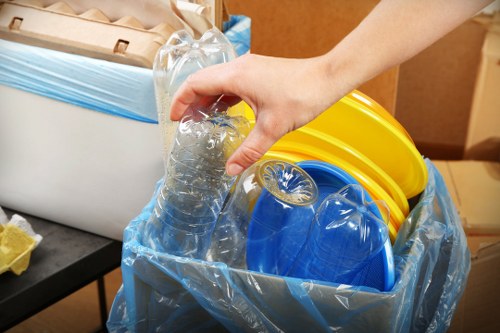Commercial Waste Disposal in Furniture Disposal

Understanding Commercial Furniture Waste
In the bustling world of business, furniture plays a crucial role in creating functional and aesthetically pleasing workspaces. However, with the constant evolution of office designs and the wear and tear of everyday use, commercial furniture often reaches the end of its lifecycle. Proper disposal of this furniture is not just a matter of aesthetics but also environmental responsibility.
Commercial waste in furniture disposal encompasses a wide range of items, including desks, chairs, cabinets, and other office furnishings. Managing this waste efficiently is essential for businesses aiming to maintain sustainability and comply with environmental regulations.
Improper disposal of commercial furniture can lead to significant environmental harm, including increased landfill waste and the unnecessary consumption of resources. Therefore, businesses must adopt effective waste disposal strategies to mitigate these issues.

Importance of Proper Furniture Disposal
Proper furniture disposal is vital for several reasons. Firstly, it helps in reducing the overall carbon footprint of a business by minimizing landfill waste. Furniture often contains materials like wood, metal, and plastics, which can be recycled or repurposed, thereby conserving natural resources.
Secondly, complying with local and national waste disposal regulations is a legal requirement for businesses. Failure to adhere to these regulations can result in hefty fines and damage to a company's reputation.
Moreover, responsible disposal practices demonstrate a company's commitment to sustainability, which can enhance its brand image and attract environmentally conscious clients and employees.

Methods of Commercial Furniture Disposal
There are several methods available for the disposal of commercial furniture, each with its own set of benefits and considerations. The choice of method often depends on the condition of the furniture, the volume of waste, and the company's sustainability goals.
Recycling
Recycling is one of the most environmentally friendly methods of furniture disposal. Many components of office furniture, such as metals, plastics, and wood, can be separated and processed for reuse. This not only reduces waste but also conserves valuable resources.
Donating
Furniture that is still in good condition can be donated to charitable organizations, schools, or non-profits. This method extends the life of the furniture and provides assistance to those in need. Additionally, businesses may benefit from tax deductions for their donations.
Reselling
Another viable option is to resell used furniture. This can be done through online marketplaces, furniture consignment shops, or internal company sales. Reselling not only generates revenue but also promotes the reuse of furniture, aligning with sustainable practices.

Environmental Impact of Furniture Disposal
The disposal of commercial furniture has significant environmental implications. Landfilling furniture contributes to the growing problem of waste management, leading to soil and water contamination over time. Additionally, the decomposition of certain materials in landfills can release harmful greenhouse gases, exacerbating climate change.
Resource Conservation
By recycling and reusing furniture, businesses can conserve natural resources such as timber, metals, and plastics. This not only reduces the demand for virgin materials but also lessens the environmental toll associated with the extraction and processing of these resources.
Energy Savings
Recycling materials typically requires less energy compared to manufacturing products from raw materials. For instance, producing aluminum from recycled sources consumes up to 95% less energy than creating it from bauxite ore. Such energy savings contribute to the reduction of overall greenhouse gas emissions.

Choosing the Right Disposal Partner
Selecting a reliable waste disposal partner is crucial for effective commercial furniture disposal. A reputable partner will offer a range of services, including pickup, recycling, and reporting, ensuring that all aspects of disposal are handled efficiently and responsibly.
Certification and Compliance
Ensure that your disposal partner is certified and complies with all relevant environmental regulations. Certifications such as ISO 14001 indicate a commitment to environmental management standards.
Comprehensive Services
A good disposal partner should provide comprehensive services tailored to your business needs. This may include on-site pick-up, dismantling of large furniture items, and detailed reporting on waste management practices.
Recycling Capabilities
Opt for partners who prioritize recycling and have the infrastructure to process various materials. This ensures that your disposed furniture is handled in an eco-friendly manner, aligning with your sustainability goals.

Cost-Effective Disposal Solutions
Balancing cost and environmental responsibility is a common challenge for businesses when disposing of commercial furniture. However, selecting the right disposal methods and partners can lead to significant cost savings in the long run.
- Reduced Waste: Efficient disposal methods minimize the amount of waste sent to landfills, potentially lowering disposal fees.
- Tax Benefits: Donating furniture can provide tax deductions, offsetting some of the costs associated with disposal.
- Revenue Generation: Reselling used furniture turns waste into revenue, enhancing the overall cost-effectiveness of your disposal strategy.
Optimizing Disposal Processes
Streamlining your disposal processes can further enhance cost efficiency. This includes scheduling regular pickups, consolidating disposal activities, and maintaining an inventory of reusable or recyclable items.
Investing in Sustainability
While there may be initial costs associated with adopting sustainable disposal practices, the long-term benefits often outweigh these expenses. Sustainable practices can lead to increased operational efficiency, improved brand reputation, and compliance with evolving environmental regulations.

Best Practices for Commercial Furniture Disposal
Implementing best practices in furniture disposal ensures that the process is efficient, compliant, and eco-friendly. Below are several strategies businesses can adopt to optimize their disposal efforts.
Inventory Management
Maintaining an accurate inventory of furniture can help in planning disposal activities. By tracking the lifespan and condition of each item, businesses can make informed decisions about when and how to dispose of them.
Employee Training
Educating employees about proper disposal practices fosters a culture of sustainability within the organization. Training can cover topics such as sorting materials, identifying recyclable components, and understanding the importance of responsible disposal.
Regular Audits
Conducting regular audits of your disposal processes helps identify areas for improvement. Audits ensure compliance with regulations and assess the effectiveness of current strategies, facilitating continuous enhancement of waste management practices.

Technology in Furniture Disposal
Advancements in technology have revolutionized the way businesses approach furniture disposal. Innovative solutions enable more efficient sorting, tracking, and recycling of waste materials.
Waste Management Software
Implementing waste management software can streamline the disposal process by providing tools for tracking inventory, scheduling pickups, and generating compliance reports. This technological integration enhances transparency and efficiency in waste management.
Recycling Technologies
Modern recycling technologies allow for the effective separation of materials, ensuring that each component of the furniture is processed appropriately. Automated sorting systems, for example, increase the accuracy and speed of recycling operations.
Data Analytics
Utilizing data analytics helps businesses gain insights into their waste generation patterns. Analyzing this data enables the identification of trends, facilitating better decision-making and the optimization of disposal strategies.

Regulatory Framework for Furniture Disposal
Understanding the regulatory framework governing commercial furniture disposal is essential for businesses to ensure compliance and avoid legal repercussions.
Local Regulations
Local governments often have specific regulations regarding waste disposal, including licensing requirements, prohibited materials, and disposal methods. It is imperative for businesses to familiarize themselves with these local laws to ensure adherence.
National Standards
At the national level, various standards and guidelines dictate the proper disposal of commercial waste. Organizations such as the Environmental Protection Agency (EPA) provide comprehensive guidelines that businesses must follow to maintain compliance.
International Regulations
For businesses operating on a global scale, international regulations may also apply. Compliance with international standards ensures that disposal practices are consistent and environmentally responsible across different regions.

Case Studies: Successful Furniture Disposal
Examining case studies of businesses that have successfully implemented effective furniture disposal practices can provide valuable insights and inspiration.
Company A: Comprehensive Recycling Program
Company A established a comprehensive recycling program that focuses on segregating materials and partnering with local recycling facilities. This initiative reduced their landfill waste by 60% and saved significant disposal costs annually.
Company B: Donation and Resale Strategy
Company B adopted a dual approach of donating usable furniture to non-profits and reselling items in good condition. This strategy not only minimized waste but also generated additional revenue streams and enhanced the company's community engagement.
Company C: Technology Integration
Company C integrated advanced waste management software to streamline their disposal processes. The technology enabled accurate tracking of furniture inventory, optimized pickup schedules, and ensured compliance with environmental regulations.

Challenges in Commercial Furniture Disposal
Despite the availability of various disposal methods, businesses often face challenges when managing commercial furniture waste. Identifying and addressing these challenges is crucial for effective waste management.
- Volume of Waste: Large-scale operations generate significant amounts of furniture waste, making disposal logistics complex.
- Cost Constraints: Budget limitations can restrict the adoption of environmentally friendly disposal methods.
- Regulatory Compliance: Navigating the complex web of local, national, and international regulations can be daunting.
Solutions to Overcome Challenges
To overcome these challenges, businesses can adopt strategic approaches such as partnering with specialized disposal companies, investing in sustainable technologies, and implementing comprehensive waste management plans.
Continuous Improvement
Embracing a mindset of continuous improvement ensures that businesses remain adaptable and proactive in addressing emerging waste management issues. Regularly reviewing and updating disposal strategies can lead to more effective and sustainable practices.

The Future of Furniture Disposal
The landscape of commercial furniture disposal is evolving, driven by technological advancements and increasing environmental awareness. The future holds promising developments that will further enhance the efficiency and sustainability of waste management practices.
Circular Economy
The concept of a circular economy emphasizes the reuse and recycling of materials to create a closed-loop system. In furniture disposal, this means designing products with end-of-life recycling in mind and creating systems that facilitate the continuous reuse of materials.
Innovative Materials
Advancements in material science are leading to the development of more recyclable and biodegradable materials for furniture manufacturing. These innovations will simplify the recycling process and reduce the environmental impact of disposed furniture.
Smart Disposal Systems
The integration of smart technologies, such as the Internet of Things (IoT) and artificial intelligence (AI), into waste management systems will enable more efficient and accurate disposal processes. These technologies can optimize routing for pickups, predict waste generation patterns, and enhance recycling accuracy.

Conclusion
Effective commercial waste disposal in furniture disposal is a critical component of sustainable business practices. By understanding the importance of proper disposal, exploring various methods, and overcoming common challenges, businesses can significantly reduce their environmental impact.
Choosing the right disposal partners, adopting advanced technologies, and staying informed about regulatory requirements are essential steps toward achieving responsible waste management.
As the business landscape continues to evolve, embracing sustainable disposal practices will not only benefit the environment but also enhance the reputation and operational efficiency of businesses.
Take Action Today
Don't wait to make a positive impact. Contact us today to learn how our commercial waste disposal services can help your business achieve its sustainability goals. Book your service now and take the first step toward a greener future.